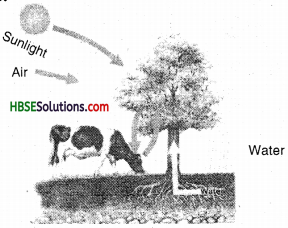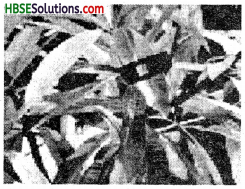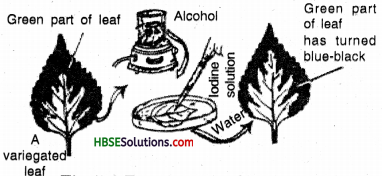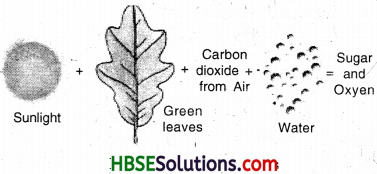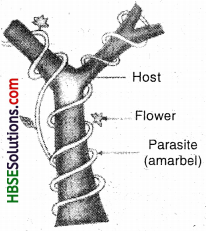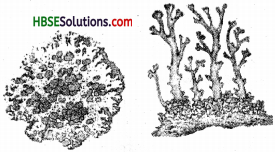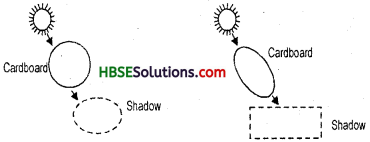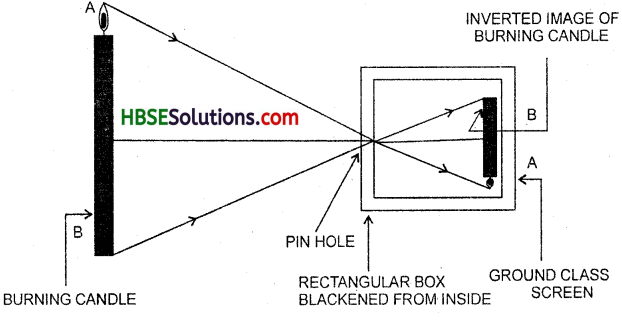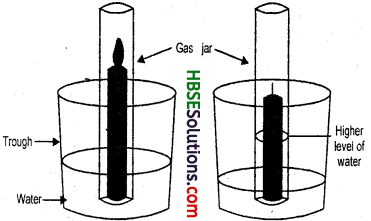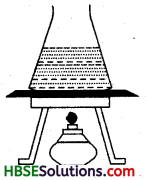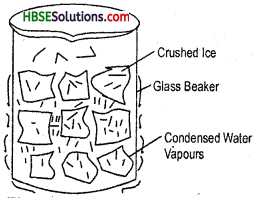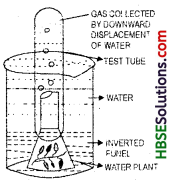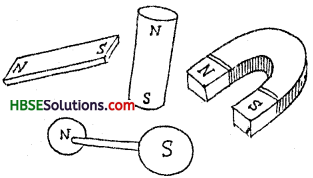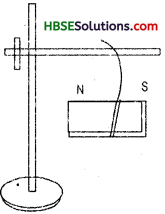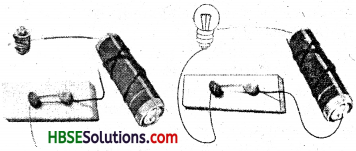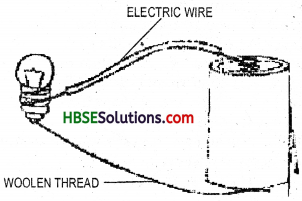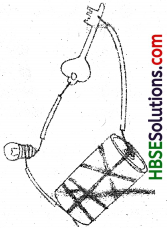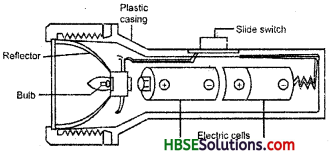HBSE 7th Class Science Solutions Chapter 2 Nutrition in Animals
Haryana State Board HBSE 7th Class Science Solutions Chapter 2 Nutrition in Animals Textbook Exercise Questions and Answers.
Haryana Board 7th Class Science Solutions Chapter 2 Nutrition in Animals
HBSE 7th Class Science Nutrition in Animals Textbook Questions and Answers
Question 1.
Fill in the blanks:
(a) The main steps of digestion in humans are …………… , …………… , …………… , …………… , and …………… .
(b) The largest gland in these human body is …………… .
(c) The stomach releases hydrochloric acid and …………. juices which act on food.
(d) The inner wall of the small intestine has many finger-like outgrowths called …………… .
(e) Amoeba digests its food in the …………… .
Answer:
(a) ingestion, digestion, absorption, assimilation, egestion
(b) liver
(c) digestive
(d) villi
(e) food vacuole.
Question 2.
Mark T if the statement is true and F if it is false:
(а) Digestion of starch starts in the stomach.
(b) The tongue helps in mixing food with saliva.
(c) The gall bladder temporarily stores bile.
(d) The ruminants bring back swallowed grass into their mouth and chew it for some time.
Answer:
(a) False
(b) True
(c) False and
(d) True.
Question 3.
Tick (✓) mark the correct answer in each of the following:
(a) Fat is completely digested in the:
(i) stomach
(ii) mouth
(iii) small intestine
(iv) large intestine.
Answer:
(iii) small intestine.
(b) Water from the undigested food is absorbed mainly in the:
(i) Stomach
(ii) food pipe
(iii) small intestine
(iv) large intestine.
Answer:
(iv) large intestine.
![]()
Question 4.
Match the items of column I with those given in column II:
| Column I | Column II |
| Food Components | Product (s) of Digestion |
| (i) Carbohydrates | (a) Fatty acids and glycerol |
| (ii) Proteins | (b) Sugar |
| (iii) Fats | (c) Amino acids |
Answer:
| Column I | Column II |
| Food Components | Product (s) of Digestion |
| (i) Carbohydrates | (b) Sugar |
| (ii) Proteins | (c) Amino acids |
| (iii) Fats | (a) Fatty acids and glycerol |
Question 5.
What are Villi? What is their location and function?
Answer:
Villi are the finger like structures which are the form of internal layer. They are situated in the stomach.
Functions:
(i) Villi provides space for food.
(ii) Digestive juice is secreted out from the digestive glands present in the Villi in the embedded form.
(iii) The food is grinded by the contraction and expansion of Villi.
Question 6.
Where is the bile produced? Which component of the food does it digest?
Answer:
The liver secretes bile juice that is stored in a sac called the gall bladder. The bile plays an important role in the digestion of fats.
Question 7.
Name the type of carbohydrate that can be digested by ruminants but not by humans. Give the reason also.
Answer:
The grass is rich in cellulose, a type of carbohydrate. Many animals, including humans, cannot digest cellulose. The cellulose can be digested by ruminants but not by humans because they have a large sac-like structure between the small intestine and large intestine. The cellulose of the food is digested here by the action of certain bacteria which are not present in humans.
Question 8.
Why do we get instant energy from glucose?
Answer:
We get instant energy from glucose, because in the cells, glucose breaks down with the help of oxygen into carbon dioxide and water and energy is released.
Question 9.
Which part of the digestive canal is involved in:
(i) absorption of food
(ii) chewing of food
(iii) killing of bacteria
(iv) complete digestion of food
(v) formation of faeces.
Answer:
(i) small intestine
(ii) buccal cavity
(iii) stomach
(iv) small intestine
(v) large intestine.
Question 10.
Write one similarity and one difference between the nutrition in Amoeba and human beings.
Answer:
Similarity: In both, the process of digestion involves ingestion, digestion, absorption, assimilation and egestion.
Difference: In Amoeba, the enzymes secreted by the call cytoplasm digest the ingested food.
In man, there are special organs for the digestion of food. The food passes through the alimentary canal. Here several digestive enzymes are secreted. These enzymes break the complex food materials into simpler ones.
Question 11.
Match the items of column 1 with suitable items in column II:
| Column I | Column II |
| (a) Salivary gland | (i) Bile juice secretion |
| (b) Stomach | (ii)Storage of undigested food |
| (c) Liver | (iii) Saliva secretion |
| (d) Rectum | (iv) Acid release |
| (e) Small intestine | (v)Digestion is completed |
| (f) Large intestine | (vi)Absorption of water |
Answer:
| Column I | Column II |
| (a) Salivary gland | (iii) Saliva secretion |
| (b) Stomach | (iv) Acid release |
| (c) Liver | (i) Bile juice secretion |
| (d) Rectum | (vii) Release of faeces |
| (e) Small intestine | (v)Digestion is completed |
| (f) Large intestine | (vi)Absorption of water |
![]()
Question 12.
Label following figure of the digestive system.
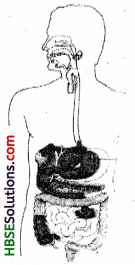
Answer:
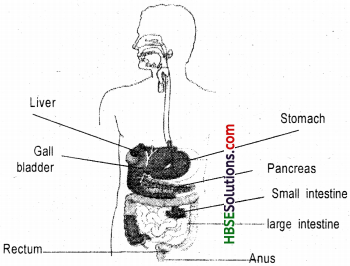
Question 13.
Can we survive only on raw, leafy vegetables/grass? Discuss.
Answer:
No, we cannot survive only on raw, leafy vegetables/grass, Discuss of this topic in your class and ask to your teacher.
Extended Learning Activities And Project
Question 1.
Visit a doctor and find out:
(i) Under what conditions does a patient need to be on a drip of glucose?
(ii) Till when does a patient need to be given glucose?
(iii) How does glucose help the patient recover?
Write the answers in your notebook.
Answer:
Do yourself. Consult your family doctor and ask these Questions.
Question 2.
Find out what Vitamins are and get the following information.
(i) Why are Vitamins necessary in the diet?
(ii) Which fruits or vegetables should be eaten regularly to get Vitamins?
Write a one-page note on the information collected by you. You may take help of a doctor, a dietician, your teacher or any other person, or any other source.
Answer:
You have learnt about vitamins in class VI (chapter 2 – components of food).
Question 3.
Collect data from your friends, neighbours and classmates to find out about “milk teeth”. Tabulate your data. One way of doing it is given below:
| S. No | Age at which first tooth fell | Age at Which last tooth fell | No. of teeth lost | No. of teeth replaced |
| 1. 2. 3. 4 5. |
Find out from at least twenty children and find the average age at which children lose the milk teeth. You may take help of your friends.
Answer:
Do yourself. Take help to your classmates and friends.
HBSE 7th Class Science Nutrition in Animals Important Questions and Answers
Very Short Answer Type Questions
Question 1.
Name the body parts that capture food in Hydra, Amoeba.
Answer:
Hydra-tentacles, Amoeba-Pseudopodia.
Question 2.
Name the important parts of the digestive system of human body.
Answer:
(i) Mouth with buccal cavity
(ii) Oesophagus
(iii) Stomach
(iv) Duodenum
(v) Small intestine
(vi) Large intestine
(vii) Anus.
Question 3.
Name three parts in which digestion takes place in the digestive system of human body.
Answer:
(i) Buccal cavity
(ii) Stomach
(iii) Small intestine with duodenum.
Question 4.
In which part of the digestive system absorption of water takes place?
Answer:
Absorption of water takes place in large intestine.
![]()
Question 5.
What are Villi?
Answer:
Villi are the finger like folds in the inner walls of stomach.
Question 6.
What is the fuel for energy production in cells?
Answer:
Carbohydrates acts as the fuel for energy.
Question 7.
Name Five steps in the process of nutrition.
Answer:
1. Ingestion
2. digestion
3. absorption
4. assimilation and
5. egestion.
Question 8.
In which part of the alimentary canal
(a) absorption of water takes place
(b) assimilation of digested food occurs?
Answer:
(a) Large intestine
(b) Small intestine.
Question 9.
In which two parts of man does much of the digestion take place?
Answer:
In stomach and small intestine much of the digestion take place.
Question 10.
What are pseudopodia?
Answer:
Amoeba constantly changes its shape and position. It pushes out one, or more finger-like projections, called pseudopodia or false feet for movement and capture of food.
Question 11.
Name the organ of the digestive system where digestion of food of all types takes place.
Answer:
Small Intestine.
Question 12.
Is the large intestine really large?
Answer:
No. The large intestine is wider and shorter than small intestine. It is about 1.5 metre in length.
Question 13.
Where does digestion start in humans?
Answer:
In humans, digestion starts in stomach.
![]()
Question 14.
Name the largest gland in the human body.
Answer:
Liver is the largest gland in the human body.
Question 15.
Name three ruminant animals.
Answer:
1. Cow
2. Buffalo and
3. Horse.
Question 16.
Define ruminants.
Answer:
Herbivores like cow, buffalo etc. first swallow the food without chewing it. After some time, they bring back the swallowed food to their mouth from the pouch of the stomach. Then they again grind the food well and swallow it. It is called chewing of the cud. These animals are known as ruminants.
Question 17.
What are incisors?
Answer:
Incisors are the flat front teeth. These have a sharp straight edge that help us to cut food and hence, they are also called cutting teeth. There are four incisors in each jaw.
Question 18.
What are canines?
Answer:
Canines are the pointed teeth present on either side of the incisors. These help us to tear the food and hence, they are called the tearing teeth. There are two such teeth in each jaw.
Question 19.
Define ingestion.
Answer:
Ingestion is the process by which food is taken by the organisms.
Question 20.
Define digestion.
Answer:
Digestion is the process of breaking down complex food molecules into similar molecules and is brought about with the help of special molecules called enzymes.
Question 21.
Define egestion.
Answer:
Egestion is the process by which undigested food is removed from the body.
Question 22.
Define absorption.
Answer:
The process by which the digested food molecules are taken up (or absorbed) by the intestine wall and sent to the circulatory system is called absorption.
Question 23.
What is assimilation?
Answer:
Assimilation is a process of conversion of absorbed food into body. For example, in man and other higher animals, the blood carries the food to different parts of the body for incorporation into cell components.
Question 24.
What is gall bladder?
Answer:
The liver secretes juices which help in digestion and are stored in a small bag called the gall bladder.
![]()
Question 25.
In which part of the digestive system and assimilation of food takes place?
Answer:
In human digestive system. Digestion takes place in buccal cavity, stomach and small intestine. Assimilation takes place in small intestine.
Question 26.
Write two functions of Villi.
Answer:
(i) Villi provides space for food.
(ii) Digestive juice is secreted out from the digestive glands present in the villi in the embedded form.
Question 27.
What is the function of oesophagus?
Answer:
No digestion takes place here. It only helps in pushing the food into stomach.
Question 28.
What is amylase?
Answer:
Saliva contains an enzyme called amylase. Amylase acts on starch and changes it into a sugar (called maltose).
Question 29.
Name the two processes of respiration.
Answer:
Inhalation and exhalation are the two processes of respiration.
Question 30.
Name the cells that carry water and food in the body of a green plant.
Answer:
Cells of Xylem vessels.
Short Answer Type Questions
Question 1.
How do the different animals procure food?
Answer:
Different organisms procure different methods. There are special structures in each organism for taking in food, for example, frog uses its sticky tongue to catch the prey. Butterfly has probosces (special mouth parts) to suck nectar from flowers. The housefly also lives on liquid food. It also has feeding tube to suck the liquid food. A spider spins a web to catch small insects. Human beings use hands to put their food in the mouth.
![]()
Question 2.
What are the stages in the process of Nutrition?
Answer:
The food taken into the body by an animal is processed further to derive nutrients from it. There are five stages in the processing of food in an animal.
These include:
(i) Ingestion
(ii) Digestion
(iii) Absorption
(iv) Assimilation
(v) Egestion.
Question 3.
“What do you understand by digestive enzymes?” How does amylase affect starch?
Answer:
Digestive enzymes are the special proteins secreted out in gastric glands, small intestine and in pancreas. Specific enzyme helps in digestion of specific food item.
Amylase is the enzyme secreted in the pancreatic juice which converts carbohydrates (Polysaccharides) starch into Maltose sugar (Disaccharides).
Question 4.
How does nutrition occur in amoeba?
Answer:Amoeba
constantly changes its shape and position. It pushes out one, or more finger-like projections, called pseudopodia or false feet for movement and capture of food.
Amoeba feeds on some microscopic organisms. When it senses food, it pushes out pseudopodia around the food particle and engulfs it. The food becomes trapped in a food vacuole. Digestive juices are secreted into the food vacuole. They act on the food and break it down into simpler substances. The absorbed substances are used for growth, maintenance and multiplication. The undigested residue of the food is expelled outside by the Vacuole.
Question 5.
How does nutrition occur in paramecium?
Answer:
In paramecium, the food is ingested with the help of small hair-like structures present on the cell membrane. These are called the cilia. The food passes to oral groove from the cell membrane and then enters the mouth. From the mouth the food is taken inside the main body, where the food vacuole helps in its digestion with the help of enzymes. The undigested food is excreted with the help of contrectile vacuole.
Question 6.
Differentiate between absorption apd assimilation.
Answer:
Absorption:
It is a process by which digested food gets absorbed. The soluble food materials pass through the wall of digestive tract and reach the circulatory system or body fluid of an organism. In human beings and in other higher organisms, absorption takes place in the small intestine.
Assimilation:
It is a process of conversion of absorbed food into body. For example, in man and other higher animals the blood carries the food of different parts of the body for incorporation into cell components.
Question 7.
Write short note on small intestine.
Answer:
Small intestine is a long coiled tube. It also secretes a juice and digestion of all types of food is carried out here. As a result of digestion, food is converted into simple form, and glucose, amino acid and fatty acides etc. are formed. These end products are ready for absorption. Small intestine also absorbs the digested food and passes it on to the blood system. Thus, the nutrients are carried to all parts of the body.
Question 8.
What happens to the digested food in our bodies?
Answer:
Our body requires energy to carry out the various activities of life. We get this energy from the food we eat. This happens during respiration. The food which we eat is digested in the alimentary canal. But the alimentary canal alone does not require food. It must go to all parts of the body. The digested food is absorbed by the small intestine and passed on to the blood. Through the blood, the absorbed food is carried to all parts of the body.
![]()
Question 9.
Why is the process of excretion important for living organisms?
Answer:
In all the living beings the metabolic activities take palce within the body for getting energy. The remaining part of the food is called as the waste material which are harmful to the body. So to become healthy and for proper functioning it is essential to pass these wastes from the body.
Question 10.
What are the main organs of the digestive system in our body?
Answer:
The process of digestion starts in the mouth. From the mouth, the food passes through a food canal (called alimentary canal).
Alimentary canal is a long, muscular and coiled tube, it starts from the mouth and ends at anus.
The different organs of the alimentary canal are as follows:
1. Mouth and mouth cavity.
2. Oesophagus (gullet or food pipe)
3. Stomach.
4. Small intestine.
5. Large intestine.
6. Anus.
Associated with the alimentary canal are some glands. These are:
1. Salivary glands
2. Liver
3. Pancreas.
The alimentary canal along with the associated glands is called the digestive system.
Question 11.
Write the functions of tongue.
Answer:
Tongue, a muscular organ, is also important for eating and performs several functions:
(i) It helps in mixing the chewed food with saliva
(ii) Swallowing the food
(iii) The tongue tastes, as it has sense organs called the taste buds.
These buds distinguish four basic tastes-salty, sour, sweet and bitter. In addition, it helps us to speak.
Question 12.
What are salivary glands?
Answer:
There are three pairs of salivary glands in our mouth. A watery material called saliva is secreted by these glands. Saliva helps in the digestion of food. Saliva contains an enzyme called amylase (also called ptyalin). Amylase acts on starch and changes it into a sugar (called maltose). The sugar is sweet and soluble in water.
Question 13.
What is meant by excretion? Explain its need for the sustenance of the individual.
Answer:
Excretion is the passing out of the metabolic wastes from the body through special organs known as excretory organs. The excretory matter, if it is present in the body, will disturb the metabolic activities going on in different parts of the body and also become hurdle in the circulation. It will disturb metabolic activity in body. So it is necessary to excrete out all the metabolic wastes from the body.
![]()
Long Answer Type Questions
Question 1.
Name the different types of teeth in an adult man and state their functions. Also give a labelled diagram of different types of teeth.
Answer:
There are four main kinds of teeth in humans-incisors, canines, premolars and molars.
The front four teeth in each jaw are the incisors. They are flat and help in biting the food. On either side of the incisors are the canines. These are sharp and two in number in each jaw. They are meant for tearing the food. The premolars and molars are meant for grinding and crushing the food. Premolars are behind the canines, two in number on either side in each jaw.
Molars are behipd the preiholars. In an adult, they are six in number in each jaw, three each on either side of the premolars. In young people there are 8 molars in all. The second set of 4 molars appears at the age of eighteen or even later. These are called the wisdom teeth. Each jaw in an adult has 16 teeth, or 32 teeth in all.

Question 2.
Describe briefly the different stages involved in the process of nutrition.
Answer:
The different stages involved in the process of nutrition are:
1. Ingestion:
It is a process of taking in food. It differs from animal to animal, for example, frog uses its tongue to catch its prey, human beings hold food with hands and put it into their mouth, etc.
2. Digestion:
It is a process of breakdown of complex food materials such as carbohydrates, fats, proteins etc, into simpler forms. It is both a mechanical and a chemical process.
3. Absorption:
It is a process by which digested food gets absorbed. The soluble food materials pass through the wall of digestive tract and reach the circulatory system or body fluid of an organism. In human beings and in other higher organisms, absorption takes place in the small intestine.
4. Assimilation:
It is process of conversion of absorbed food into body. For example, in man and other higher animals, the blood carries the food to different parts of the body for incorporation into cell components.
5. Egestion:
It is the process by which the undigested food is eliminated from the body. In man and other organisms, it is carried out through the anus.
Question 3.
Name the things which help in physical and chemical digestion.
Answer:
The things which help in physical digestion are as follows:
(а) Tongue and Teeth: They masticate and chew the food. The tongue helps in this process.
(b) Villi of Stomach: By peristeltic movement villi help in mixing the digestive juices with the food.
The things which help in chemical digestion are as follows:
(а) Saliva: It contains ptyalin which convert carbohydrates of food into maltose sugar.
(b) Hydrochloric acid: It provides the acidic medium to the food.
Gastric Juice: It contains pepsin enzyme which converts protein into peptone.
(c) Pancreatic juice: It contains three enzymes.
Trypsin: Which converts peptone into amino acid.
Amylopsin: Which converts maltose sugar into sugar.
Stepsin or lypase: It converts fat into fatty acid and glycol.
(d) Intestinal juice: Which converts the remaining part of food into soluble form.
![]()
Question 4.
‘Excretion is a process to eliminate waste by products from the body’. Justify the statement.
Answer:
In all the living beings the biochemical reactions go on continuously which are commonly named as metabolism. It is of two types i.e., anabolism and catabolism. During anabolism the simple compounds combine together to form complex compounds while in catabolism the complex compounds are oxidised and convert into simple compounds and energy. These by products are waste and harmful substances. They are to be expelled out from the body.
If these wastes remain inside the body they will combine together to form other compounds which may be poisonous or more harmful to the body. They may become hurdle to the activities and also may cause death. So the catabolic by products should be passed out from the body. These products are called excretory matter and the organs through which they are expelled, are called excretory organs and the process is called as excretion.
Question 5.
What are the various components of blood? Give their functions.
Answer:
The various components along with their functions are as follows:
Blood Plasma: It is the liquid of the blood which carries food materials, water and other excretory matter to all parts of the body.
Corpuscles:
They are of the three following types:
1. Red Blood Corpuscles (R.B.C.): They carry oxygen to all cells of all parts of the body.
2. White Blood Corpuscles (W.B.C.): They are uninucleated and amoeboid in shape. They light against the disease germs.
3. Blood Platelets: They are spindle shaped and help in clotting the wounds.
Nutrition in Animals Class 7 HBSE Notes
- Animal nutrition includes nutrient requirement, mode of intake of food and its utilisation in the body.
- Digestion is the process of breaking down complex food molecules into simpler molecules and is brought about with the help of special molecules called enzymes.
- The human digestive system consists of the alimentary canal and secretory glands. It consists of the (i) buccal cavity, (ii) oesophagus, (iii) stomach, (iv) small intestine, (v) large intestine ending in rectum, and (vi) anus.
→ The main digestive glands which secrete digestive juices are (i) the salivary glands, (ii) the liver and (iii) the pancreas. The stomach wall and the wall of the small intestine also secrete digestive juices. - Different organisms possess different structures for procuring food.
- Digestion is a complex process involving: (i) ingestion, (ii) digestion, (iii) absorption, (iv) assimilation and (v) egestion.
- Digestion of carbohydrates, like starch, begins in the buccal cavity. The digestion of protein starts in the stomach. The bile secreted from the liver, the pancreatic juice from the pancreas and the digestive juice from the intestinal wall complete the digestion of all components of food in the small intestine. The digested food is absorbed in the blood vessels in the small intestine.
- The absorbed substances are transported to different parts of the body. Water and some salts are absorbed from the undigested food in the large intestine.
- The undigested and unabsorbed residues are expelled out of the body as faeces through the anus.
- The grazing animals like cows, buffaloes and deer quickly swallow the grass and store it in a separate part of the stomach called rumen. Here the food gets partially digested and is called cud. But later the cud returns to the mouth in small lumps and the animal chews it. This process is called rumination and these animals are called ruminants.
- Amoeba feeds on some microscopic organisms. When it senses food, it pushes out pseudopodia around the food particle and engulfs it. The food becomes trapped in a food vacuole.
HBSE 7th Class Science Solutions Chapter 2 Nutrition in Animals Read More »

